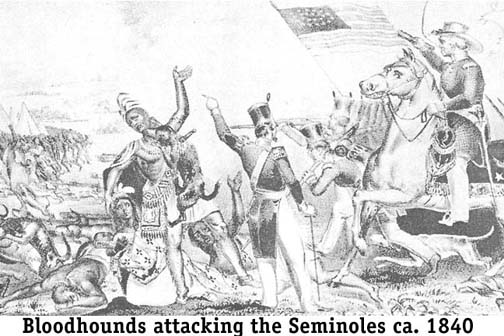|
SEMINOLES By Jerry Wilkinson |
 |
|
SEMINOLES By Jerry Wilkinson |
 |
|
At best this is an abbreviated history of the Native Americans, but not
Native Floridians. Early European settlers found many Indian tribes in
the southeast who were later called "The Creek Confederacy." In these
early
times it was difficult to label a group of Indians as a nation, tribe
or
band. The Indians were given all kinds of names, usually depending upon
the mood of the white settler. Studies have shown that the Indians
seldom,
if at all, referred to themselves when talking amongst themselves by
the
names given to them by the European settlers.
This applied equally to the indigenous Florida Indians. The principal groups were the Timucua in the northeast, the Apalachee in the northwest, the Calusa (Caloosa, Coloosa, Caluse, Calos, Carlos, etc.) in the southwest and the Tequesta in the southeast. It is thought that the Tai'no Indians of Cuba and the Bahamas were also included. It is estimated that the total indigenous Florida Indians exceeded 100,000 at the time of Ponce de Leon (1913). The Spanish brought with them the word "Cacique," now pronounced Ka-SEEK-kay, meaning chief. It is believed by most to have been an Arawak Indian word from the islands. The Spanish usually used the words 'rey' (King), jefe (chief or boss) or commandante (commander) when referring to Spanish chiefs. About 10,000 BC Florida’s first people arrived south of the continent's glacier fields to a land more hospitable and with an easy food supply. These people are referred to as Paleo-Indians. Archaeologists proceed through three later periods (Archaic, Woodland and Mississipian) to begin the Historic Period in AD 1500. At this time we begin to get a few written glimpses of the geography and the people of the New World. For this article the native people in 1500 AD will be referred to as the indigenous Indians. The spellings of their names varied greatly from writer to writer. The groups of indigenous Florida people (Indians) were given names by the European such as Apalachee, Timucan, Tocobaga, Calusa, Tequesta, Matecumbe, etc. These were the people that De Soto, Ponce de Leon, Fontaneda, etc. encountered and wrote of in the early 1500s. The name Seminole was not mentioned. The indigenous Indians immediately to the north of Florida were given names such as Creek, Mikasuki, Yamassee, Yuchi, Oconee, Guale, Eufala, etc. There was no mention of the Seminoles there either. From AD 1500 to 1600 there were primarily exploratory expeditions, slavers and shipwrecked Europeans in North America except for St. Augustine and Pensacola. Remember however, there were extensive European invasions from Mexico to South America. Beginning with Jamestown, permanent groups of English colonizers came to North America. You know the story. The Native Americans were forced to migrate away from the invading Europeans. Since they could walk farther than they could swim, they generally migrated westward. At first in the south the Europeans were not interested in areas where there were not deep water seaports and where the “fevers” (Marlaria, Yellow, Dengue) were prominent. Therefore, the indigenous Florida Indians more or less had 99 percent of Florida land. By the 1700s Europeans had migrated into present-day Carolinas, Georgia, Tennessee and Alabama areas. The prehistoric Florida Indians were significantly reduced in number by disease and early Spanish slavery. We will never know exactly, but in the early 1700s a significant sized group of northern Indians moved to Florida. The groups' names vary (namely Creek); however, a 1716 group of Yamassee Indians from present-day Georgia is well documented. From then on Indians north of Florida began colonizing Florida just as the Europeans colonized their former lands. Georgia had formed a buffer area until the formation of the new English Colony of Georgia in 1732. This forced even greater numbers of southeastern natives to flee generally westward. Some chose to separate, or detach themselves, from the general westward migration and go southward. Florida was close, easy to get to and there was little resistance. North Florida had many rivers flowing from north to south and in desperation, down these rivers they migrated. The prehistoric Florida Indians, who had been here for centuries, either were killed, taken as slaves, died of disease, or absorbed into the new northern tribes. Spain more or less had protected the Indians if they left the few Spanish settlements alone, or would be candidates for Christian conversion. This separation of the Carolina, Georgia and Alabama Indians could have given rise to the name Seminole. The Creek word ishi semoli literally means “the people whom the Sun God does not love.” Actual use is more like a separatist, seceder, runaway or a wildness. The word also could have come from the Spanish word Cimarron, a domesticated animal that has returned to the wild. Those who separated and came to Florida became known as Seminoles. They could have even been named by their northern relatives, or even themselves. It appears that this entire group became Seminoles just as all the Europeans became known as Americans- by definition and usage. Both were an amalgam of many different blood relations and languages, but were a kind of socio-political alliance as well as with familial, cultural and linguistic ties. The Seminole Alliance would have been a better descriptive name, as they were composed of many Indian tribes. Seminole did not indicate a blood lineage as did Mikasuki, Yuchi, Oconee, Yamassee, etc. There were also two different dialects of a common language stock, Muskogee and Hitchiti. Muskogee was used for treaties, conferences and trade contracts. This was a problem for the Mikasuki and others, who spoke Hitchiti. All tribal and individual names were given by the white men. I believe this is an important date: The first official written use of the word “Seminole” that I find was by British Superintendent of Indian Affairs of the Southern District, John Stuart, in 1771. John Stuart did not list the "Seminoles" in his earlier 1764 treatise. (This is rather late in time so it would be a good research project for some one to discern if it were used in an earlier time.) In 1763, Spain traded all of Florida to England for the return of Havana which it had captured. It is generally believed that all the remaining indigenous Florida Indians went to Cuba with the Spanish when the government changed. However, there were probably some who had intermarried with the Seminoles, or some who remained in the Everglades or Keys. Also probable, of those who went to Cuba, a few returned by way of the Keys. Anyway, the new native Floridian was not native to Florida at all. The fact that they were not indigenous, that Florida was not their native land, was constantly argued by the Florida whites to move them out. Therefore, writings of Florida and Keys Indians before 1700 generally refer to the indigenous Florida Indians e.g., Calusa, Matecumbe, Tequesta, Tocobaga, Timucan, etc. After the late 1700s writings should refer to the Seminole Alliance e.g., Mikasuki, Creek, Yamassee, Yuchi, Oconee, etc. In between 1700 and the late 1700s, they could be one or the other, or both, but more likely the Seminole as the indigenous were small in numbers and decreasing almost daily. The Seminole Alliance groups had penetrated most of Florida by 1760. An example is the nine Spaniards who were attacked at Key West by a band of 48 Yuchis in February 1762. We should not ignore the Negro contingent of the Seminoles. Many were runaway slaves from such notable African tribes as the Ibo, Egba, Senegalese and the famed Ashanti. They also migrated to Florida and the “Seminoles” generally protected them. At the time Florida became a territory in 1821, there were about 34 Seminole settlements - 31 Indian and 3 Negro. By the time of the American Revolution in 1776, a large group of Lower Creeks (Seminoles) had forged as far south as the northeast area of present-day Tampa. In 1783, the British returned ownership of Florida to Spain to prevent control by the U.S., but Spain was now a weak, war-weary nation. Spain could no longer protect the Florida borders. The Indians moved farther into central and southern Florida, as the Europeans primarily wanted the coastline for seaports. More Free Negroes and runaway Negro slaves poured into Florida. The Spanish did little concerning this border conflict. The Seminoles actually prospered during the English period. They traded effectively with the British and the Spanish. In the war of 1812, the Creeks again sided with the English. General Andrew Jackson severely trounced the Creeks in the Creek War (1813-1814) that quickly followed. At the Battle of Horseshoe Bend on March 27, 1814 under the command of Jackson, the Creeks ceded two-thirds of their land. Large numbers of the Creek “Red Stick” tribe escaped into Florida. This caused the existing Florida Indians to have even less living area. The total Indian population of Florida was estimated at 6,000, but no one knows. The First Seminole War (1817-1818) was precipitated when a Seminole chief named, Neamathla, warned U.S. troops not to trespass on their hunting grounds. About 250 soldiers responded to his warning by attacking the Indian village. The Indians retaliated attacking a boatload of 40 soldiers and the war was on. Again, General Jackson intervened and was victorious. The next 50 years of war was disastrous for the Seminoles. At that time Florida was under the control of Spain. In 1819, Spain ceded Florida to the U.S. for $5 million to settle damage claims by American citizens lodged against Spain. After the treaty was ratified by Congress, Secretary of State John Quincy Adams issued to General Jackson on March 12, 1821 three commissions as Florida’s military governor: (1) receive, possess and occupy the ceded lands, (2) to govern Florida, (3) and to establish a territorial government. All of these required dealing with the Seminoles. On September 6, 1823 near St. Augustine 70 Seminole chiefs met with Florida’s new governor, William DuVal, to discuss their removal. The Seminoles were officially recognized as an Indian Nation. They were sent to a reservation in central Florida. Therefore, at the time that Florida became U.S. property the Seminoles had only been in Florida some 120 years. They were Native Americans, but not Native Floridians. |
